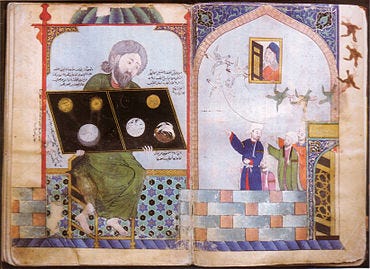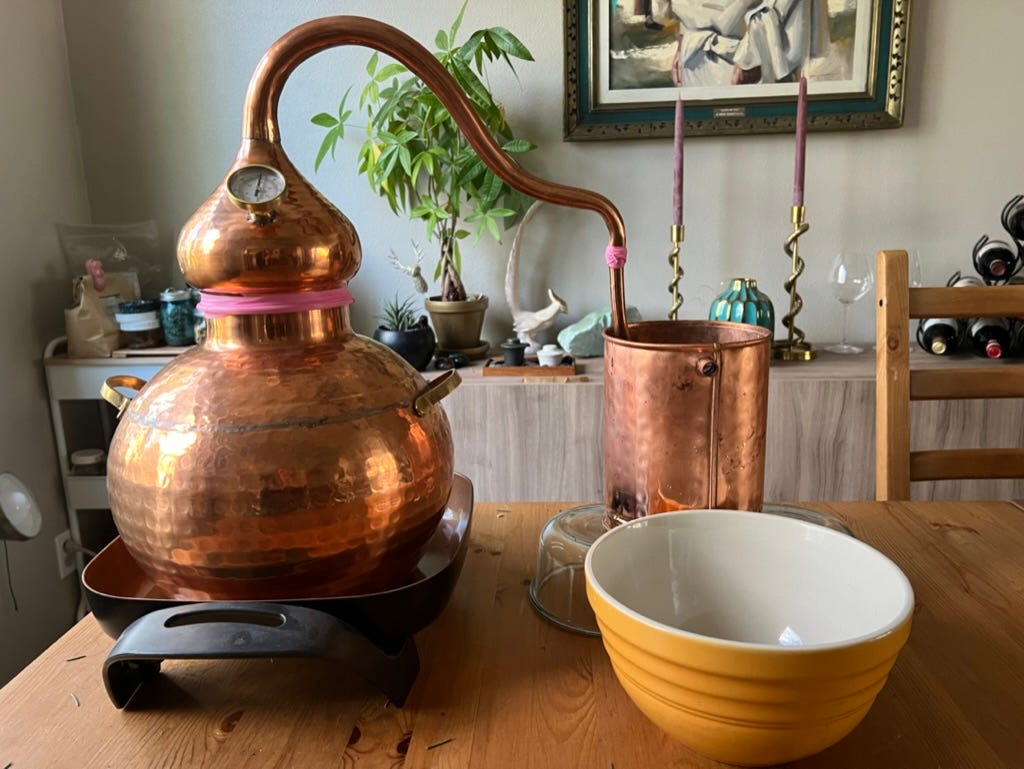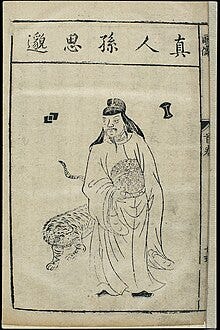The alchemist is in session ;)
Above is a picture of my copper alembic. I love it.
And, it took me two years to be brave enough to start using it, lol. Supposedly there can be a risk of explosion with these things…
Luckily, I have an engineering wizard of a man who put his skills to use getting me all set up this year.
Over the summer and into early fall, our home smelled of fresh herbs and fragrant forests as I transformed wild and garden-grown plants into alchemical elixirs, mantra and blessings infusing the precious distillations.
Blue spruce, white mountain sage, and magical mugwort are a few of the first allies who have participated in this botanical alchemy, transforming from fresh plants into healing hydrosols. Fragrant wormwood, incense cedarwood, and fresh local juniper berries are on deck, so long as I can get to them before the snow and frost set in fully.
As I tend my alembic to facilitate the transformation of these plants, I feel gratitude for the long line of alchemists who have come before me. I feel their wisdom, skill, and reverence for this process all around me, holding me within a sacred vessel of support as I do this work.
Now, steeped in aroma and the healing blessings of the plants, I come to share a bit more about this process — because I know some of you may be thinking, “Cool…but what is an alembic? What is a hydrosol? How on earth would I use one?”
I got you. And in this article, we will dive into all these questions and more ;)
Ancient Alchemy: Distillation of Spirit
There’s a reason alcohol is often referred to as “spirits” — the earliest alchemists believed the distillation process extracted the spiritual essence of plants. Since the result of botanical distillation was often alcohol, this literally intoxicating liquid became known as spirits.
As with so many gifts from the gods, humans have created an often warped and dysregulated relationship with these liquid spirits. Yet this doesn’t mean they are inherently bad — it is pure, organic, distilled alcohol that provides the base of the sacred perfumes I create. Pure, organic alcohol, distilled from grapes in my home state of Oregon preserves the vibrational imprints of my flower essences.
In these magical, botanical remedies, alcohol isn’t just a preservative or base — it is an essential spiritual component of these botanical elixirs, helping to carry the spiritual nature of their gifts into our bodies, where we may receive great benefit.
Yet it wasn’t only alcohol that arose from distillation…
Steam Distillation with Fragrant Aromatics
When fresh, fragrant plants are steamed in alchemical vessels, precious aroma chemicals can be captured in the form of essential oils and botanical waters — this is called steam distillation. Preparing steam distillations with my copper alembic lets me transform fresh, wild plants into magical remedies and elixirs.
Here’s how steam distillation works: First, water and fresh plants, which contain volatile aroma chemicals and compounds, are placed in the bowl of a still (an alembic is a type of still). This is heated, and the steam rises — only the most volatile components rise in this steam, leaving the heavier plant chemicals behind. As the aromatic steam condenses back into water, it carries these compounds with it. Some compounds are water soluble, so they remain in the water, and others are not — these become essential oils that float on top of the water.
So, this distillation creates two different magical and healing plant remedies:
Essential Oils — You’ve probably heard of these guys ;) These are the condensed, aromatic molecules that are not soluble in water. They are highly concentrated and potent, and only a tiny amount can be extracted from the whole plant materials.
Hydrosols — This is the recondensed aromatic steam, containing the water soluble molecules. It is gentle, fragrant, and full of very pure healing plant materials. Not as potent as essential oils, not as physically dense as a tea, hydrosols are unique distillations with their own alchemical gifts.
What Are Hydrosols, and How Are Hydrosols Different from Essential Oils?
While both hydrosols and essential oils come from the same distillation process, they are quite different in their composition and potency.
Distinctive Features of Essential Oils
Essential oils are condensed, aromatic molecules that you’ll find floating on top of your hydrosol, their presence given away by an oily sheen.
Essential oils float on top because they are not water soluble — rather, they are lipid-based and most soluble in fats and oils.
They are also extremely concentrated — only a few drops are produced per gallon of water used in the distillation process.
It takes a huge amount of plant material to make a single drop of essential oil, so they are very precious materials to use with great care.
Since the water has been removed from essential oils, they are more shelf-stable and longer lasting than hydrosols.
Distinctive Features of Hydrosols
Hydrosols, also known as floral waters or hydrolats, are the aromatic waters produced during a steam distillation of plant material.
Since they rise in steam, hydrosols contain water soluble molecules.
And, since the steam distillation process creates a large amount of hydrosol, they tend to be fairly diluted in their potency.
These qualities make them both more sustainable and gentle than essential oils — they are often used with sensitive individuals, children, and pets.
Being water-based, hydrosols have a lighter, subtler scent and shorter shelf life than essential oils — a batch generally lasts about a year or two in a cool, dark place.
Ancestral Uses of Hydrosols
Historical evidence of distillation dates back thousands of years on multiple contents, with steam distillation happening extensively in Egypt, the Mediterranean, Persia, India, and China. (The copper alembic, which is what I use, likely originated with Muslim alchemists in the Islamic Golden Age, around the 8th/9th century.)
In every country we find evidence of distillation, we can see that hydrosols were used in ritual and spiritual practices, medicine and healing, food and flavoring, and perfume and beauty.

In the past, it’s likely that the hydrosol itself was the primary aim of the distillation process, and the essential oils were either skimmed from the surface or simply mixed in — and this is really important to remember:
So often, we think that more is better. More potent, more healing, right? Not necessarily. For thousands of years, hydrosols were incredibly valuable and revered for their medicinal properties.
The earliest use of hydrosols probably dates back to ancient Egypt and Mesopotamia, a world in which boundaries between perfume, medicine, and ritual were nonexistent.
Evidence shows that some of the earliest plants to be distilled were likely pines and junipers, along with lavender and rosemary.
In ancient Greece, hydrosols were used along with infused oils for cleansing, pathing, and ritual purification. As time went on and the use of hydrosols spread throughout Europe, health and beauty became the focus — rosewater being a favorite in both England and France.
I’m particularly drawn to the Taoist practices of the Han Dynasty in China. There is a long, beautiful history of using both hydrosols and essential oils in the Jade Purity lineage of Sun Simiao, which we’ll be diving into more deeply with my Nectar & Alchemy programs next year…
But in brief: Sun Simiao was a revered physician who used hydrosols and essential oils to anoint specific acupoints to bring about deep healing. His work was so effective that he became renowned throughout the land and was called to serve as a court physician.
This is one of my favorite ways to use hydrosols today — anointing key acupoints, often related to the eight extraordinary vessels, to bring about deep, soul-level transformation and healing.
And when I get to use hydrosols that I’ve myself, from plants grown on my own land and harvested by my own hands, the results are even more profound.
The Unique Benefits of Hydrosols
Among all the wonderful ways we can partner with plants, a few benefits make hydrosols a unique kind of remedy:
Hydrosols are very safe. Unlike essential oils and herbal remedies, hydrosols are incredibly gentle. While you should always check for contraindications and allergies, in general, you can safely use hydrosols with children, pets, and the elderly, making them wonderfully accessible remedies.
Hydrosols are energetically potent. Hydrosols are primarily energetic in nature, yet retain light and pure physical properties, as well. This combination helps us receive their gifts in every level of our being.
Hydrosols are more sustainable. For every drop of essential oil created, a gallon or more of hydrosol is made. This means that we can use far less plant material and still receive profound benefits, which makes hydrosols a more ecologically sustainable option for plant healing.
Hydrosols last under the right conditions. Kept in a cool, dark place (such as a refrigerator) and free from contamination, hydrosols will last 1-2 years without any added preservatives. While this isn’t as long as an essential oil or tincture, it is a lot longer than a tea or infused water — and pretty amazing considering no preservatives are needed!
How to Use Hydrosols
Healing, spiritual practice, fragrance and flavor, beauty…the many historical uses of hydrosols carry forward into our lives today. You can be endlessly creative with your hydrosol use, so here are just a few ideas to get started:
1. Make an aromatic mist
Use a single hydrosol, combination, or add essential oils and other plant extracts to create an aromatic mist. These mists can be used as you would any other aromatherapy spray — for beauty, cleansing, aroma, protection, refreshment…get creative!
2. Flavor your food and drinks
Add a teaspoon of hydrosol to a glass of water, use rosewater in a Mediterranean dessert, add orange blossom water to a honey cake, blend an herbal hydrosol into a salad dressing…most hydrosols are totally edible, so have fun in the kitchen. (If the plant isn’t edible, don’t eat the hydrosol!)
3. Apply topically
Hydrosols are safe to use directly on the skin — even with children and pets. Soaking some cotton pads in antiinflammatory hydrosols and applying to puffy eyes or irritated skin feels so soothing, and antibacterial hydrosols can be dabbed onto scratches.
4. Use ritually
Hydrosols can safely enhance any ritual intentions. Mist your space, attune your energy field to practice by taking a few drops internally, and cleanse your ritual objects.
5. Anointing
Hydrosols are beautiful for any anointing practice — whether you are opening your third eye before meditation, attuning your heart to its highest vibration, or practicing traditional acupoint anointing in the TCM style, hydrosols carry the vibrational gifts of plants deep into your body’s energy system.
6. Support your health
All of the wellness benefits of the plants involved are carried into their hydrosol form. So, use peppermint and chamomile for digestion, tea tree and sage for antibacterial purposes, helichrysum for skin health, and lavender for a calm mind. Once again, there are endless possibilities.
Psst — this list just scratches the surface! Download 44 more creative ways to use hydrosols—my gift to you!
2024 Hydrosol Collection
Ok, now that you have some idea about how totally magical hydrosols are, and how many ways you can use them (although, honestly, my favorite is just to mist my face for hydration and a mood boost throughout the day), I hope you’ll be inspired to start incorporating them into your own daily rituals.
Right now, there are 4 freshly made hydrosols in the botanica at Alchemessence. Obviously, pretty limited amounts are available.
Here’s a peek at who you’ll find:
Mugwort — Mugwort has a long history as a sacred herb for enhancing dreams, intuitive work, and protection. Known for its ability to clear energetic blockages, Mugwort supports relaxation, enhances spiritual practice, and aids meditation.
White Sagebrush — A lovely, local, and sustainable white sage from the artemisia family, this hydrosol purifyies the mind, body, and spirit. It helps clear emotional clutter, provides mental grounding, and energetically prepares you for spiritual practices.
Blue Spruce — This hydrosol captures the spirit of evergreen forests, bringing about feelings of peace and strength. Blue Spruce hydrosol is wonderfully grounding, helping to clear mental fog, support emotional balance, and create a sense of calm stability.
Purple-Leaf Chokecherry Blossom — This unique hydrosol offers us gentle emotional healing and reminds us of the sweetness of life. It provides calming support for the nervous system, uplifts the heart, and enhances a sense of connectedness and harmony.




Big Plant Product Drop 2024
In addition to these hydrosols, I have a batch of new magical plant medicines coming out any day now! I’m putting the finishing touches on everything, so hopefully they’ll be available by the end of the weekend — I’ll email my newsletter and share on Notes here on Substack when everything is live :)
Look for healing salves, protective body oils, aromatic spirit sprays, and new flower essences!
Limited stock so buy soon if you want to secure your goodies…but yes, there will absolutely be Black Friday specials on these ;)





